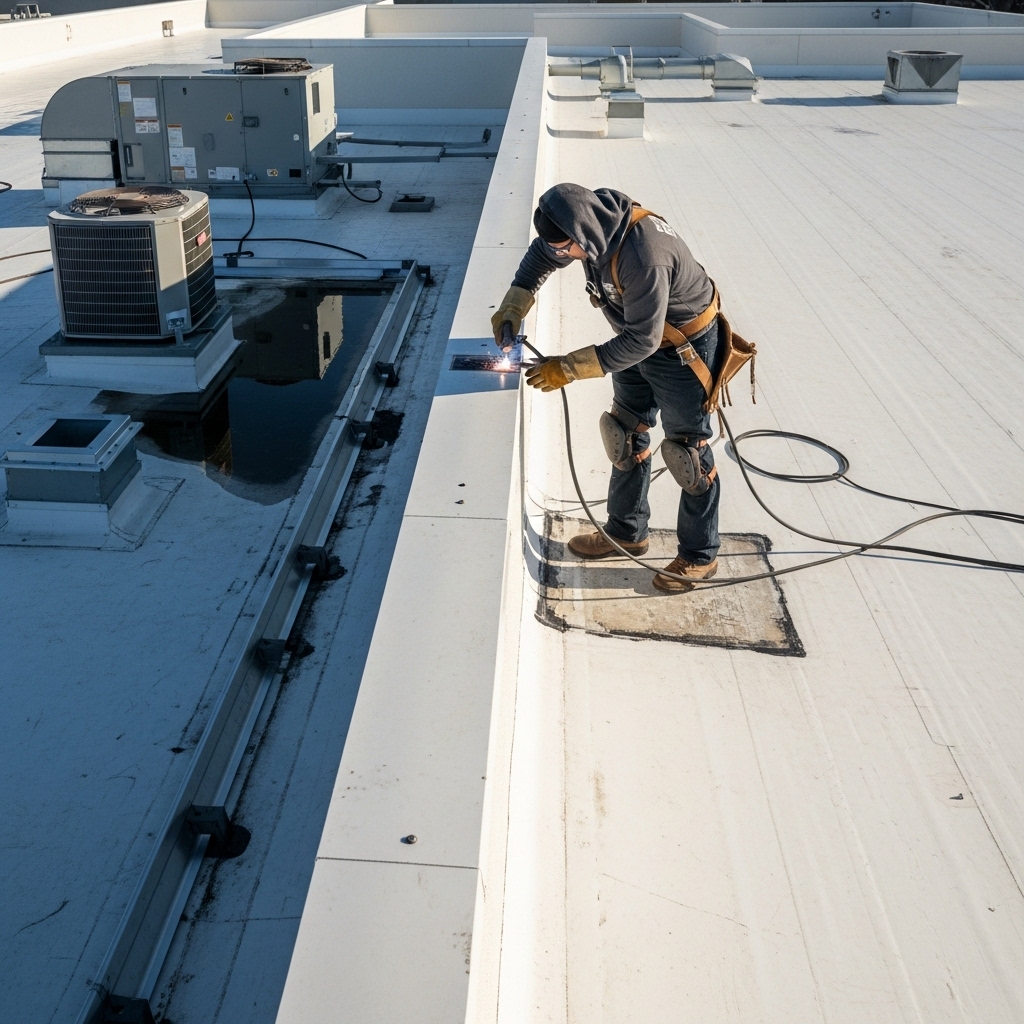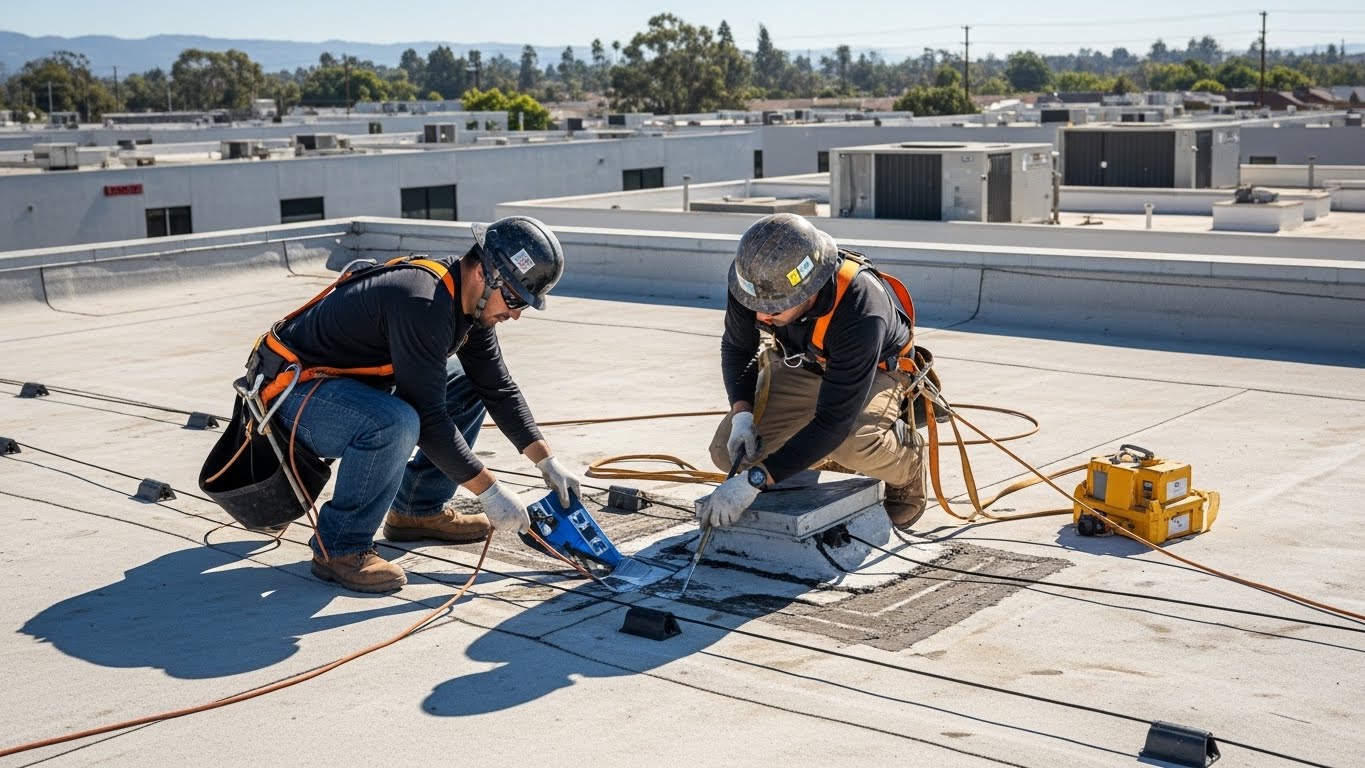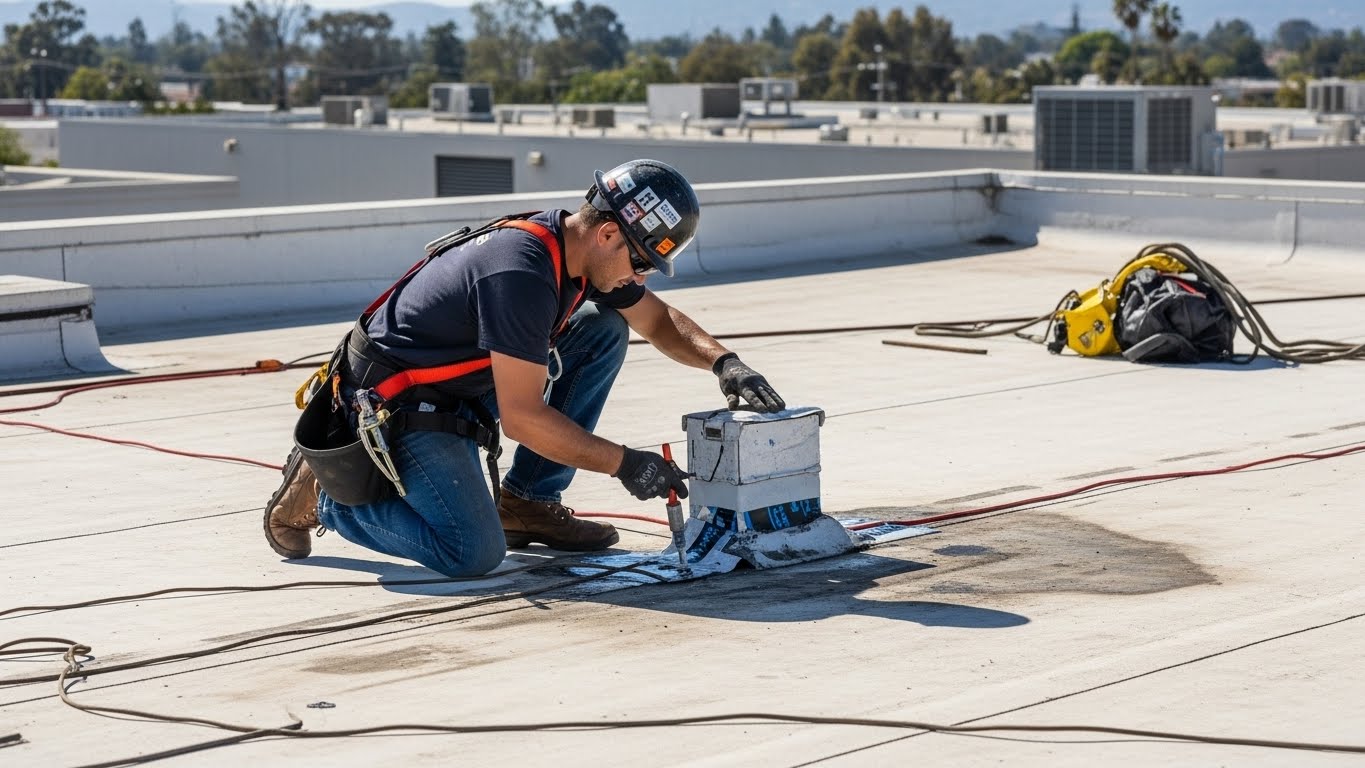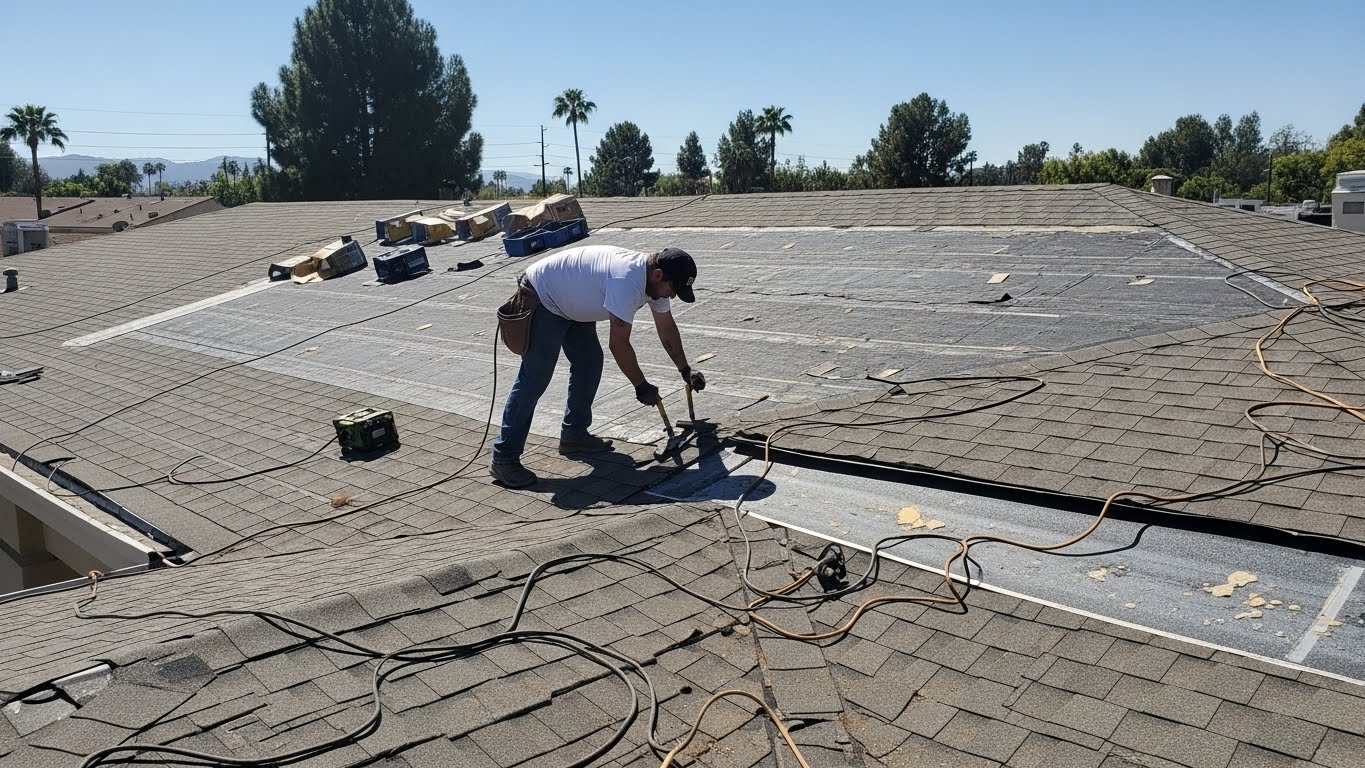Stand on any rooftop along Ventura Boulevard and you’ll see the working skyline of Tarzana: restaurant exhaust fans, satellite dishes, HVAC units, parapets, and a carpet of white or silver membranes stretching in every direction. These flat and low-slope roofs are the unsung machinery of our commercial buildings. They keep inventory safe, kitchens humming, and offices comfortable, but when they leak, operations can grind to a halt. As local specialists, we’ve learned that effective flat roof repair here is part detective work, part craft, and part coordination. It starts with understanding how heat, UV, and rooftop traffic stress every seam, flashing, and penetration—and it ends with a repair that holds through windy evenings and the next rare but soaking rain. If you need a team that can navigate tight access, tenant schedules, and building standards without disrupting your day, you’ll appreciate the precision we bring to every commercial roof repair.
Flat roofs in Tarzana usually fall into a few categories: single-ply membranes like TPO and PVC, modified bitumen, and older built-up assemblies with gravel. Each system has its own failure modes and its own best repair practices. TPO and PVC are light-colored for energy performance, but their thermoplastic nature means seams and flashings rely on flawless welding, and they grow less forgiving with age and UV exposure. Modified bitumen is robust and repairable, yet it can develop splits where the roof flexes near equipment curbs or along parapet transitions. Built-up roofs are durable but can hide moisture beneath the surface, especially where gravel has created miniature dams around drains.
Diagnosing leaks on these roofs means starting at the roof’s low points and perimeters. Ponding near drains is a frequent culprit; even shallow standing water can magnify tiny imperfections. We test drains and scuppers for free flow, inspect for shiners and fastener back-out along mechanical attachments, and probe seams to ensure welds are continuous. At equipment curbs, we check for membrane “fishmouths,” corner cracks, or improper terminations where an installer ran out of height and relied too heavily on sealant. We also look for signs of foot traffic damage, like crushed insulation or scuffed membrane where technicians access units without walkway pads.
When repairs are approved, our methods follow manufacturer best practices. On TPO or PVC, we clean, prime if required, and heat-weld new patches with rounded corners over properly prepared substrate. At seams, we might add a cover strip to extend the lap beyond minimums if we see movement. On modified bitumen, we cut back to sound material, feather edges, and install reinforced plies set in compatible adhesives or asphalt, ensuring perimeter terminations are mechanically secure. For built-up roofs, we excavate wet or blistered areas, dry the deck if it’s safe to do so, and rebuild plies to match, making sure any gravel surfacing is restored to promote drainage rather than ponding.
Parapet walls and edge metal deserve special attention. They are often the first place where wind-driven rain tests a roof. We confirm that base flashings climb high enough and remain married to the wall surface with the correct fastening and termination bars. At coping caps, we evaluate joints for openness and ensure cleats are secure so caps don’t rack under pressure. Where masonry walls have cracked, we create a flexible interface that absorbs movement so the roof system doesn’t tear at the corner. These details are the quiet backbone of a leak-free flat roof in our valley winds.
Another hot spot in Tarzana is the restaurant roof. Grease and kitchen exhaust degrade many membranes, making them brittle and less reflective. We add sacrificial protection around exhaust fans, install or refresh grease containment where needed, and use reinforced patches that resist chemical exposure. For multi-tenant buildings, we map each tenant’s equipment so the responsibility for maintenance is clear, and we provide photo documentation that building managers can share without multiple site visits.
Access and safety can’t be afterthoughts. Many buildings have roof hatches tucked in back corridors or narrow exterior ladders. We plan staging to keep customers and staff safe, and we coordinate work windows to avoid peak business hours. If a repair requires temporarily shutting down an HVAC unit or power to a small area, we communicate that plan early and stick to the schedule so tenants can prepare. Our goal is to fix the roof without becoming the story of the day for your operations team.
Flat roof leaks don’t always come from above. Condensation inside rooftop ducts can drip onto membranes and mimic roof leaks. We watch for staining patterns and inspect duct insulation and seals, particularly after HVAC work. We also check for negative pressure at doors and vents that could pull rain into the building envelope, creating leaks that appear far from the actual entry point. Bringing these building science insights to the repair saves time and frustration for owners and facility managers alike.
Preventive care is the best friend of a commercial roof. A twice-yearly walkthrough before and after our wet season removes debris, tests drains, tightens loose terminations, and spots early signs of membrane fatigue. In Tarzana’s heat, this routine guards against UV-brittling, which tends to show up at seams and corners first. It also gives us a baseline set of photos so any new anomalies are obvious and easy to prioritize. The modest time investment prevents the surprise of a leak on a busy workday.
When is a repair enough, and when should you plan for partial replacement? It depends on the concentration of issues and the roof’s age. If moisture intrusion is isolated to one side or to a handful of details—say, a series of poorly flashed curbs—targeted repairs are usually the most cost-effective, buying years of service. If the membrane is globally fatigued, with widespread seam failure or shrinking at perimeters, we will lay out options that might include overlays or phased work by section. We keep tenants’ needs at the center, sequencing repairs so businesses stay open and comfortable.
Case in point: a two-story office building just off Ventura had a recurring leak over a conference room that appeared only after night winds. Our inspection found no obvious membrane holes, but the wall flashing at a parapet was too short and the coping joints had opened slightly, allowing wind-driven rain to blow behind the base flashing. We extended the flashing height, resealed the coping joints with new covers, and added a robust termination bar. The next storm came and went with the conference room dry, and the property manager had one less surprise on meeting days.
Another example involved a small retail strip with older built-up roofing. Drains were partially blocked with gravel, creating shallow pools that hid blisters. We vacuumed the loose gravel, repaired the blisters and wet spots, and re-spread a clean layer to maintain reflectivity and drainage. The businesses stayed open during the work, and the roof’s performance improved immediately.
Flat roof repair is a craft that rewards patience and precision. It’s about knowing when to peel back layers, when to build them back, and how to make each transition stronger than it was before. In Tarzana, where sun, wind, and foot traffic conspire to test every weak point, that craft matters. If your roof needs focused attention without the drama, we’re ready to help with solutions that respect your building, your tenants, and your schedule. And when a bigger plan is needed, we’ll chart it together so you can budget and operate with confidence, supported by a mid-cycle strategy and a reliable roof repair partner.
What are the most common flat roof leaks on Tarzana commercial buildings?
Clogged drains and scuppers that cause ponding, cracked or low wall flashings at parapets, seam failures on aged TPO or PVC, and curb corner splits around HVAC units are at the top of the list. We also see damage from foot traffic where walkway pads are missing.
Can you repair my roof without shutting down my business?
In most cases, yes. We schedule around peak hours, coordinate any brief equipment shutdowns, and stage work to keep entrances clear. Communication is key, and we keep it tight so your operations continue smoothly.
Do you provide documentation for property managers and tenants?
Absolutely. We share before-and-after photos and concise notes that explain what we found and what we fixed. This helps managers answer tenant questions quickly and plan future maintenance.
How do you handle roofs with multiple tenants’ equipment?
We map equipment by unit, label findings, and recommend protective details like sacrificial pads or improved curbs where grease or heat threatens the membrane. Clear mapping avoids confusion and clarifies responsibilities.
When is coating a good option?
Reflective coatings can extend the life of certain membranes when the substrate is sound and seams are stable. We always repair leaks first, then evaluate whether a coating will add value or simply mask underlying issues. The building’s use and foot traffic also influence the choice.
What should we do before the rainy season?
Schedule a walkthrough to clear debris, test drains, and tighten terminations. A small amount of proactive care prevents the majority of flat roof leaks we see each year.
If you are ready to stop chasing buckets and get your building back to business as usual, we are nearby, responsive, and focused on keeping tenants comfortable and inventory protected. Let’s plan the right approach for your roof and your calendar, starting with a careful inspection and straightforward recommendations. Connect with our team to book a visit and put a dependable roof repair on the schedule so your Tarzana property stays dry, efficient, and open for business.






